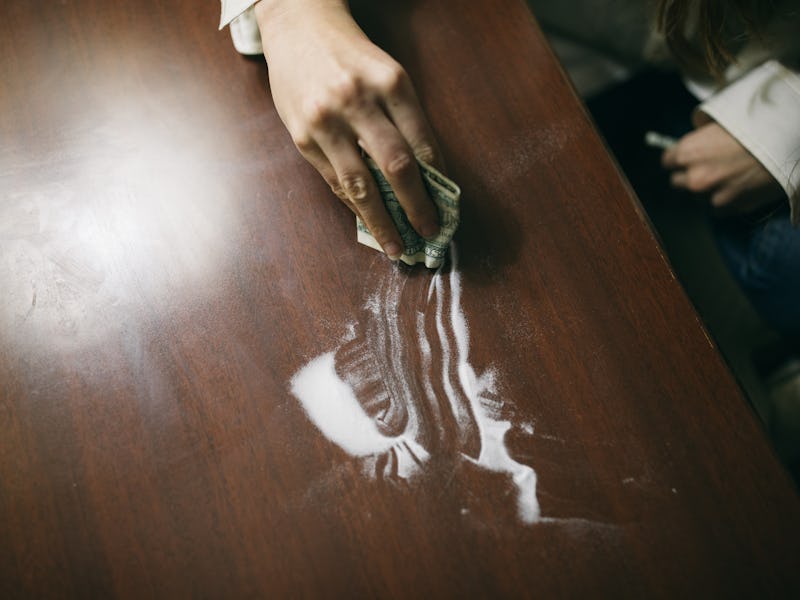Cocaine Might Be on Your Fingerprints — Even if You Don't Do Drugs
Take that, narcs.

Even if you’ve never touched a drug in your life, you could have cocaine on your fingertips. According to researchers at the University of Surrey, one in ten people who have never even used drugs are likely to have trace amounts of drugs including cocaine or heroin detectable by a fingerprint drug test.
In a study published in Clinical Chemistry on Thursday, Mahado Ismail, Derek Stevenson, Catia Costa, Roger P Webb, Marcel de Puit, and Melanie J Bailey drug-tested the fingerprints of 65 volunteers — 50 who were drug-free, and 15 who said they had taken cocaine or heroin within the past 24 hours. And despite the fact that they had never taken drugs, 13 percent of the drug-free volunteers had trace amounts of cocaine or heroin on their hands.
The researchers tested blank samples at the same time as the volunteers fingerprints to be sure that the trace drug amounts came from the fingerprints and not the lab. The fact that some people tested positive in the fingerprint drug tests wasn’t particularly surprising: cocaine can persist for a long time, and the researchers say trace amounts of the drug can be picked up on bank notes.
While completely bonkers, it also makes sense that currency would be a primary contaminant. Paper money touches many hands and can also be used to cut and ingest cocaine. Still, it’s pretty wild that 13 percent of a random sampling had enough cocaine on their fingertips to show up in a drug test. Could this unlucky subset of the population get busted for drugs they didn’t use?
Fingerprinting can establish both identity and drug use.
Thankfully, not if the researchers have anything to say about it. One of the primary goals of this study was to pinpoint a threshold to distinguish between people who actually used a drug and people who just picked up trace amounts. And it appears to have been a success.
By comparing the test results of the drug-free and the drug users, the researchers were able to set a cut-off value that can signal whether the contamination came from environmental exposure or drug use. With this threshold established, the researchers think that fingerprint drug testing could become the most timely and cost-effective way to do drug testing in the future.
But that doesn’t necessarily mean you should worry about fingerprint drug testing at the airport or other public spaces: The findings will pay dividends mostly when it comes to replacing outdated drug testing methods.
“It’s clear that fingerprint testing is the future of drug-testing. There are many factors that set fingerprint testing apart — it’s non-invasive, easy to collect and you have the ability to identify the donor by using the sample,” lead author Mahado Ismail said in a statement. “Our study will help to add another robust layer to fingerprint drug testing.”
Abstract: Background: Recent publications have explored the possibility of using fingerprints to confirm drug use, but none have yet dealt with environmental contamination from fingertips. Here we explored the possibility of establishing an environmental cut-off for drug testing from a single fingerprint.
Methods: Fingerprint samples (n=100) were collected from the hands of 50 non-drug users before and after handwashing to establish separate environmental cut-off values and testing protocols for cocaine, benzoylecgonine, heroin and 6-monoacetylmorphine. The cut-off was challenged by testing the fingerprints of drug free volunteers after shaking hands with drug users. Fingerprints from patients who testified taking cocaine (n=32) and heroin (n=24) were also collected and analysed.
Results: A different cut-off value needed to be applied, dependent on whether the fingerprints were collected as presented or after handwashing. Applying these cut-offs gave a 0% false positive rate from the drug free volunteers. The detection rate (compared to patient testimony) for washed hands of patients was 87.5% cocaine use and 100% for heroin use, after application of the cut-off.
Conclusions: Fingerprints show enhanced levels of cocaine, heroin and their respective metabolites in patients who testified taking the substances, compared with the population of naïve drug users surveyed, and a cut-off (decision level) can be established. The cut-off is robust enough to account for small increases in analyte observed after secondary transfer.